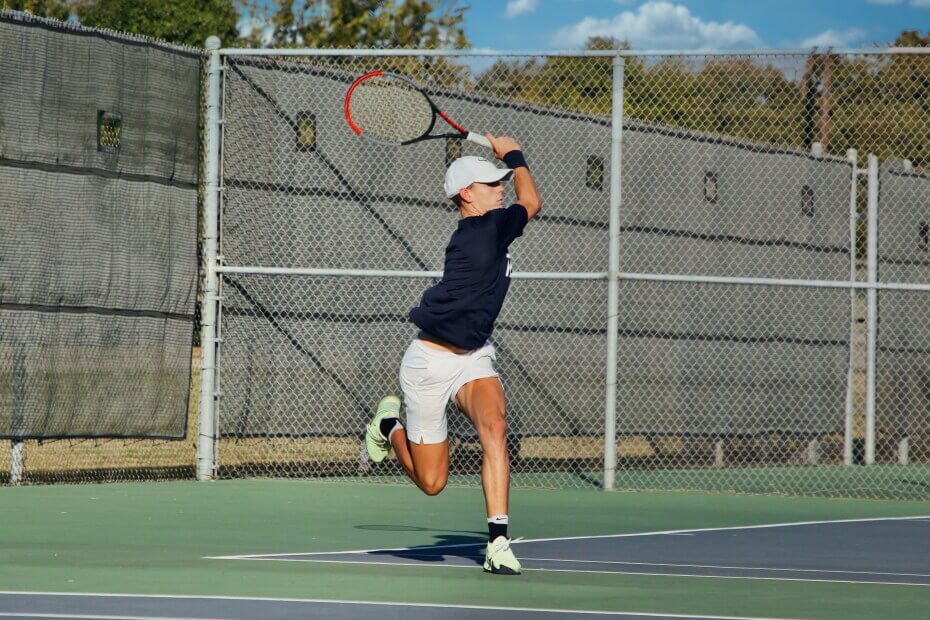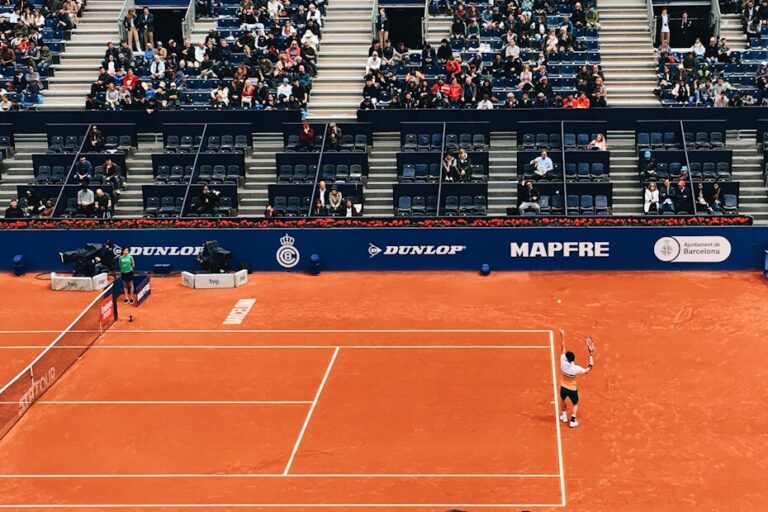Tennis is a sport that has been around for centuries and is enjoyed all around the world. The sport itself is big business and is worth some serious money, and that’s not including sponsorships, merchandise, and advertising revenue.
If you enjoy playing tennis, we can’t guarantee that you’ll reach a pro-level and will see your name in lights at Grand Slam tournaments such as Wimbledon or the US Open, but what we can guarantee is that providing you fully understand the rules, your game will improve, as will your experience on the courts.
We’re speaking about the rules of tennis today because let’s be honest, they are confusing. Not only do you have the complex terminology to wrap your head around, but you also have to understand the rules of the game completely. To novices, understanding the rules of tennis can feel like the equivalent of understanding Einstein’s Theory of Relativity. Okay, maybe we’re overexaggerating a touch, but you understand what we’re getting at, right?
To help improve your tennis game and your experience in general, we’re now going to go over how a tiebreak works in tennis, along with some of the other more complex rules of the game.
Basic Rules
We won’t insult your intelligence by explaining what a game of tennis is because you’re obviously all tennis fans or prospective tennis fans, or you wouldn’t be here reading this in the first place.
With that said, however, what we will do is look at some of the basics of tennis before we can start getting a little more in-depth and complicated.
Tennis can be played as singles in a standard 1v1 format, or in doubles, where it’s 2 teams of 2 against one another. Each team or player in a standard game of tennis will have one bounce of the tennis ball after the ball has been struck by the opposition. The aim is to return the ball over the net and into the boundaries of their opposition’s half of the tennis court. If a player or team fails to return the ball into the boundaries of their opponent’s half of the court, their opponent will score a point.
There are, of course, exceptions to this rule as there are different forms of tennis. In wheelchair tennis, for example, the players are permitted a maximum of 2 bounces of the ball because it is much tougher than regular tennis.
Obviously, the aim of a tennis match is to win enough points for a player or team to win a game, to win enough games for them to win a set, and finally, to win enough sets to win a tennis match.
Beginning a Match
We’re leaving no stone left unturned today as we want to make sure you’re as ready as you’ll ever be when the time comes for you to hit the tennis court.
Because of this, we’re looking at some of the lesser-known aspects of a tennis match, such as what happens before a competitive match actually begins.
To start with you’ll warm up with your opponent and hit a few balls to each other, maybe the odd serve here and there. Before this, however, either team or player will spin their tennis racquet, like you would when tossing a coin. The winner of the spin will then get to choose either, to receive or to serve first, or, which side of the court to begin on, or to defer these choices to their opponent.
After this, the match is ready to begin.
Tennis Scoring System
Just to complicate matters further, tennis has a slightly more unorthodox and unique scoring system when compared with other sports. In football/soccer for example, when a team scores a goal they get 1 goal. Score 2 goals and they got 2 goals up, and so on. With tennis, though, things are different.
The point scoring system of tennis is as follows:
- 0 points: Love
- 1 point: 15
- 2 points: 30
- 3 points: 40
- Tied score: All
- 40-40: Deuce
- Server wins deuce point: Ad-in
- Receiver wins deuce point: Ad-out
Scoring a Tennis Match
Tennis is a physically demanding sport that can potentially last a very long time. In fact, the longest ever recorded professional tennis match, took place back in 2010, at the Wimbledon Tournament.
The match was contested between John Isner and Nicolas Mahut and lasted a staggering 11 hours and 5 minutes. Don’t worry, spectators weren’t treated to the match in one sitting, it was instead contested over the course of 3 days. Just to give you an idea of just how bizarre this scenario really is, the average tennis match lasts just 90 minutes.
Isner was eventually declared the winner.
But, we digress. For a tennis game to be won, a player needs to win a minimum of 4 points. So, if you are up by 40-love, 40 – 15, or 40 – 30, and you grab yourself one more point, you will be declared the winner of the game.
If the score in a game or a set is tied, ‘all’ is the term that will be used when the score is announced. Again, for transparency, if you and your opponent both happen to have won two points in a game, then the score would be 30-all.
The only time the scoring system is any different is when both players have won 3 points each and the score is 40-40. Then, the term ‘deuce’ will be used. When the score reaches deuce, one team (doubles) or one player needs to win at least 2 points in a row in order to secure victory.
If a server wins the deuce point, this is known as Ad-in. If they lose the deuce point, this is known as Ad-out. If the player or team with the advantage (Ad-in or Ad-out) secures another point, they will then win the game, or it will simply go back to deuce.
What Is a Tiebreak in Tennis?
As we’re focusing primarily on a tennis tiebreak, it’s probably about time for us to actually look at it, wouldn’t you say?
A tennis tiebreaker is basically played when the score in a set is 6-6. From this point on, things get exciting as the players will then begin a ‘7-point tiebreak’ game in order for them to decide the set. In basic terms, this simply means that the first player that reaches 7 points will then be declared the victor of the tiebreaker.
The standard 7-point tiebreaker was founded back in the 1950s by James (Jimmy) H. Val Alen, who created it as a solution for tennis matches that were lengthier than players and spectators would have liked. Initially, it was a ‘first to five’ tie-breaker, though like most things, as time went on it advanced and evolved until it became the standard first to seven with a two-point margin (12 points) tiebreaker that we know, and hopefully love today.
In order for a player to win the tiebreaker game, if the score is 6-6, a player must win 2 points. So, as an example, scores could be 10 – 8, 9 – 7, 8 – 6, and so on.
Despite a tiebreaker initially being created to help shorten lengthier, drawn-out tennis matches, there is actually no limit to how high the score can go in a tiebreaker. It is, therefore, possible for a tiebreaker to end on 18-16, or higher still. In theory, it could reach something along the lines of 100 – 98. Though highly unlikely, at the end of the day, a tiebreaker in tennis will end when a player wins by 2 points.
The same rules apply to doubles tennis as well. As far as serving goes, the player who received the serve during the game that made it 6 – 6 (12th game) will start off by serving in the tiebreaker, with the player who served to make the score 6 – 6, receiving first.
Serving Order for Singles and Doubles Tennis
Serving order for singles tennis during a tiebreak is fairly straightforward. The next player who was due to serve will begin serving the tiebreak game. After serving the first point, the opponent will serve the next two points. For the rest of the tiebreak game, each player will serve two points at a time. Whoever began serving at the start of the tiebreak game will then be receiving the serve for the first game in the next set.
Serving for doubles, however, is a little more complex as there are 2 people on either half of the court.
Here, the team that served first to bring the set to 6-6 will be the receivers at the start of the tiebreak. The that begins the tiebreaker will only serve once before the opposing team serves. After this point, both teams will then serve twice and will alternate for every two serves, basically, just like you’d find in singles action.
The player that begins serving at the start of the tiebreak will be the player that did NOT serve the last game for their team.
So, as an example, if team 1 has players 1A and 1B, and team 2 has players 2A and 2B, the serving pattern will look as follows:
- Game 1 – Player 1A serves on the deuce side
- Game 2 – Player 1B serves on the ad side
- Game 3 – Player 2A serves on the deuce side
- Game 4 – Player 2B serves on the ad side
- Game 5 – Player 1A serves on the deuce side
- Game 6 – Player 1B serves on the ad side
- Game 7 – Player 2A serves on the deuce side
- Game 8 – Player 2B serves on the ad side
- Game 9 – Player 1A serves on the deuce side
- Game 10 – Player 1B serves on the ad side
- Game 11 – Player 2A serves on the deuce side
- Game 12 – Player 2B serves on the ad side
If the game is then all square at 6-6 after 12 games have been played, then a tiebreak will begin.
At the beginning of the tiebreaker, Team 1 will begin serving because of the fact that team 2 were serving for the 12th game. To get more specific too, player 1A will serve first because player 1B was serving for the last game and as per doubles rules, doubles players never serve two games consecutively.
All players will take turns serving, and again, to make things easier to understand, the serving pattern will look as follows:
- Point 1 – Player 1A serves
- Point 2 – Player 1B serves
- Point 3 – Player 1B serves
- Point 4 – Player 2A serves
- Point 5 – Player 2A serves
- Point 6 – Player 2B serves
- Players will switch ends after 6 points have been played
- Point 7 – Player 2B serves
- Point 8 – Player 1A serves
- Point 9 – Player 1A serves
This pattern of play will continue until the tiebreak comes to an end. Again, just like with singles play, a tiebreak needs to be won by 2 points. Players will switch ends every 6 points until the game has reached a climax and has drawn to a close.
Changing Ends During a Tiebreaker
In this section, let’s look at how changing ends works during a tennis tiebreaker.
To begin with, at the start of a tiebreaker, no sides are actually changed. Players remain on their half of the court for the initial 6 points of the tiebreaker.
After those 6 points have been reached, however that may be, players will then swap halves.
If the tiebreaker continues and goes a further 6 points, guess what happens? Yep, players will change ends once again. this will repeat over and over for every 6 points until the tiebreaker ends.
At the end of the tiebreak game, if there is one more set left to be played, players will swap ends depending on where they ended the tiebreak. So, if for example, player 1 ends the tiebreak on side A of the court, player 1 will begin the next set on side B of the court, on the opposite side of the netting.
There, pretty, simple, right?
Super Tiebreak
Just to complicate matters further, there is also what is known as a super tiebreak, which is basically a 10-point tiebreak.
10-point tiebreakers can be used instead of a final set if a tennis match becomes tied at one or two sets all.
In a super tiebreaker, the point system is thankfully simplified so you don’t need to be a mathematician to keep up. Points here are basically scored as 1, 2, 3, 4, 5, 6, and so on. The first team or player to reach 10 points with a 2-point margin will be declared the winner/winners.
Just like with a normal tiebreaker, if the score is tied at 10-10, play will continue until there is a winner.







